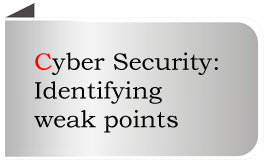

Cyber Security: Identifying weak points
It is essential for IT security professionals to find frailties in external security systems before cybercriminals seek to exploit them. Unethical hackers are always probing for gaps in the system to wreak havoc and make off with sensitive information. Cybercriminals can inflict devastating damage and the speed in which they can accomplish their task is only getting faster. With that in mind, it is paramount that security professionals are aware of common weak points.
Common weak points exploited by cybercriminals in business IT security systems
• Misused PII: Data breaches can be a result of personally-identifiable information (PII) which is lost and stolen by a third party, or accessible by unauthorized personnel
• Ambiguous legal measures/policies: Cyber criminals can manipulate unclear company, federal and local laws related to protecting personal data. When policies are under-developed or not implemented, hacking is made easier
• Inadequate Technical Security for Mission-Critical Data: Failure to encrypt sensitive information and not scheduling regular secure back-ups or audits can also create an entry point for cyber criminals. Moreover, logging controls, firewalls, anti-viruses, intrusion detection technologies and security patches must be constantly updated, in order to enhance security
• Gaps in Physical Security: When PII is not restricted to employees, limited staff and service providers, it creates a weak point in the security chain
• Inefficient Administrative Safeguards: Since the weakest security link can often be humans, companies must incorporate privacy and security training and instill the culture of data privacy within all employee groups. They must also monitor for data leakages through inventory scanning and authorization clauses
• Passwords: Most users end up selecting commonly used passwords because they are easy to remember. This is a vulnerability because it gives others a good chance to guess the correct password
Identifying potential entry points
IT professionals, CIOs and company officials can be proactive in defending their IT, by conducting a comprehensive risk assessment of various entry points. Based on the type of data and applications used by an organization, companies can identify the most common threats and install preventative measures accordingly. They can also consult with their managed services provider to implement strong security services and protocols.
Role of user awareness and behaviour on system security
It is impossible to block every security threat to your business. To a great extent, you need to rely on your employees to help keep your network safe since they may download a malicious email file attachment by mistake or click on a pop-up window that may not be safe. Employees need to be trained on IT security and made aware on the importance of system security and prevention of security attacks.
To achieve the same, it is important to ask your employees to change their behaviour in regards to how they use their IT systems. They may have to stop writing down their passwords, stop downloading new software from the Internet, and start using stronger passwords on all of their devices, even their own smartphones.
Emerging technologies and trends threatening IT security
IT networks are vulnerable to a range of threats such as malware, viruses, bots and botnets. Several data storage or sharing platforms are threatening IT security today. Specifically, the emergence of some technologies is causing security concerns:
1. Bring your own Devices (BYOD): As users use more mobile devices, information security is at risk from both internal and external threats. These include device mismanagement, software hacking, and unsecured business applications. The increasing use of apps for personal and business also provides hackers with opportunities to weaken an IT system and extract information
2. Social Media Platforms: These channels have an abundance of personal information, which can be easily sourced and misused by malicious hackers
Keeping abreast of changing trends in security—potential attacks and best practices
As enterprises grow more vulnerable to malicious invaders, spammers and hackers, they must stay ahead of the security game and adopt some best practices:
• Stay informed of new types of virus or malware in the IT domain, to take preventative measures and mitigate risks to your data
• Create a strong internal cyber-security policy and control systems, and include enforcement criteria along with consequences of non-compliance.
• Establish clear rules on third-party accessibility and control within your service provider's SLA. This is especially important when users adopt public cloud
• Encrypt your sensitive data when emailing, storing or transporting to an alternate platform; communicate over wireless connections. Additionally, enterprises must secure their endpoints with the use of Data Loss Prevention (DLP) tools, which provide visibility to incoming and outgoing traffic, blocking malicious threats and viruses and protecting internal, cloud-based data storehouses
• Consult with cloud providers who offer reliable and attractive business continuity solutions, disaster recovery and back-up plans in case of an attack
